It can be a challenge to keep kids focused on learning online with all the distractions in a home environment. But, with some simple tricks, tools, and strategies, you can teach your child how to focus on online school while improving their attention and concentration!
Thousands of schools all over the world aren’t opening this fall for the first time in modern history. Or, they’re opening under some major modifications, like our school district that’s using a “hybrid” approach of part time in-person learning.
Many families have opted to home school for the first time with so much uncertainty in the middle of the Covid-19 pandemic.
When we surveyed our audience just a few weeks ago, we received several pleas for help with online learning. Specifically, ways to improve your child’s focus, attention, and concentration in a home school environment.
The ultimate goal is to have kids as independently as possible learn as well or better than they did in a traditional school environment.
And, as an occupational therapist, I believe it’s possible.
Does Your Kid Have Focus and Concentration Issues?
At this point, most of us have experienced our kids online learning to some extent since the world shut down earlier in 2020, and you may know first hand the challenges that your child learning at home presents.
For other parents, they KNOW their child needs help attending and paying attention because they see it in other areas of their life, or know their track record in school.
Or, maybe you’re hoping you can focus on your own work-from-home since you should be working, and want to set your child up for the best possible focus so they need little or no assistance from you?
No matter what situation you find yourself in, it’s important to think through what your child’s challenges are. Think back to last April, what was the sticking point for your child…
- Did they have difficulty getting started? Logging on?
- Did they have a hard time watching lessons that were longer than 15 minutes?
- Did they get frustrated following multiple step directions?
- Did they constantly get up and walk away from their device, taking forever to finish their work?
- Did they forget to do assignments?
- Were their assignments incomplete or filled with many errors that they’d typically not get wrong?
If this is the first time your child is going to school, you might not be sure yet what might be difficult for them, but there could be other clues in their life…
- How do they attend when reading books together?
- Are they able to follow multiple step directions?
- Are they easily distracted?
- Do they play with one activity for 5 minutes? 10 minutes? 15 minutes?
Take a minute and jot down what you suspect will be or are challenges for your child’s learning. That will help you hone in on the most relevant strategies for your child below and pull together your game plan without overwhelm.
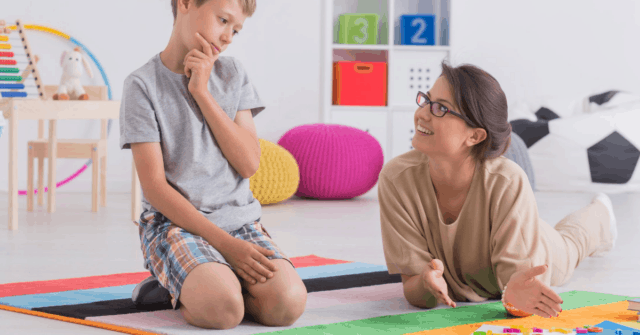
How to Keep Kids Focused for Online School
Your child may not need all of the strategies you’ll learn here, some may be more helpful than others depending on your child’s needs. Take some time to identify and make a quick plan after you read through the list below. Then, before the next time your child sits down in front of their school laptop, computer, or laptop, put your plan in place to improve their focus and attention.
As a working mom, I’ve focused on making each of these tools simple and easy to implement. You don’t need to create anything elaborate or spend a fortune on fancy sensory equipment.
Let’s get started…
Establish Flexible Routines
We all know that kids thrive off of routines and structure. It will be important to establish one at home. This makes kids feel secure and decreases anxiety because they know what to expect.
BUT, the beauty of online learning is that your routine can fit you and your child’s preferences. It can be as loose or strict as it needs to be, and it’s okay if it evolves over time.
In fact, I encourage you to let that happen. At the end of the day or the week, take a few minutes to evaluate what worked and what didn’t, make changes as you need to.
Since routines can vary widely, I wanted to give you a few examples:
Routine Example 1:
- Wake up between 8 and 8:30 everyday. Mom wakes up if child doesn’t wake up on own. Gets dressed and brushes teeth before coming to the kitchen. (A consistent wake up and bedtime are important).
- 8:45: Breakfast
- 9:15: starts first class at designated desk area, but has option to sit on a yoga ball
- 10:00: 5 minutes of a yoga video or brain break
- 11:00: 5 minute break, runs around outside or jumps up and down the stairs
- 11:30: Eats lunch
- 12:15: Back to school work, but has option to use an alternate location. Has fidgets and weighted lap pad available
- 1:00: Lays on the floor to do work and takes frequent sips from a water bottle
- 2:00: Eats a crunchy snack and does 20 jumping jacks
- 3:00: School is over, given time to decompress in a quiet sensory room, sensory tent, or an activity of their choice.
Routine Example 2:
- Wake up at 7-7:30: Allowed to stay in pajamas as long as they like.
- 8:00: Crunchy breakfast with protein and fruits/veggies
- 8:30: Bounces on trampoline/rides bike/runs for 15 minutes before starting school
- 8:45: School starts, child chooses where they’d like to sit (make sure no other noises or screens are audible). Provide headphones
- 9:30: Movement break (learn more about movement breaks below)
- 10:30: Crunchy snack, popsicle, or smoothie
- 11:15: Movement break
- 12:00: Lunch
- 12:45: Movement break
- 1:30: Chews gum and stands while completing school work
- 2:15: Movement break
- 3:00: School is over, give 2-3 options of activities such as quiet time, screen time, or playing outside
These routines are just examples to give you an idea of where to start! Think back to your child’s needs and make a rough plan, being ready to adapt as needed.
Choose Some Dedicated Learning Spaces
Some kids can work in chaotic or busy environment, and some can’t. Take a minute to carefully evaluate the space or spaces where you child will be doing their online learning. Is there a table or desk that’s cleared off and ready for them? One that will always be available for them to do their school work and learning at?
Are their multiple spaces that they can rotate between?
Choose at least one, or perhaps several spots that they could work in, especially to start their day or when they really to need to concentrate. Make sure you show your child their space and tell them that this is a special spot for them to do school.
Keep in mind though that some kids will benefit from having the flexibility to watch a video while laying on the couch, but can sit at their desk, for example, to practice writing.
Affiliate links used below. See our full disclosure.
Eliminate Distractions as Much as Possible
If there are papers, toys, and other piles of life laying around, make an effort to straighten up before school starts the evening before hand. The visual distraction can make it difficult for them to pay attention.
I love this idea from lauren.otmama
You’ll also want to think about the lighting. Is it dark? Are there lights that are too bright? Is a soft lamp available or seating near a window with natural light? Having a room too bright, too dark, too noisy, in some cases too quiet, can all make it hard for a child to concentrate.
If you aren’t sure what helps your child, start paying attention to the environment and see if changing any of the noises or lights helps or hurts their focus.
In addition to the environment, have their regular school supplies handy.
If your child has to go hunting for a glue stick, scissors, erasers, the charger for their computer, or a sharp pencil, they could have a hard time re-focusing back to the activity they’re trying to complete. Think about using their book bag, pencil boxes, and binders the same way they would as school.
Lastly, make sure that other family members aren’t watching TV or using a device with the sound on in the same room or nearby. It can be very difficult for some children to ignore those distractions, let alone focus on their work.

Take Purposeful Breaks
One challenge with online learning is that you can end up plopped in front of a computer and barely moving all day. It’s critical we remind kids and give them the chance to take a break for at least a few minutes at regular intervals throughout the day.
If your child has trouble returning to learning after break periods, set a timer to help them know when the break is over. This visual timer is helpful for kids who can’t tell time yet.
Some kids will benefit from just moving to a different seat and flipping through a book or magazine, but many will need some movement. That movement can be as simple as running around outside for 5 minutes, walking around the house, or taking a ride down the street on their bike. But, movement breaks can also involve yoga, stretching, dancing, and brain break videos.
All of which can also be as short as a few minutes or as long as 40 minutes depending on the flexibility you have in your online school.
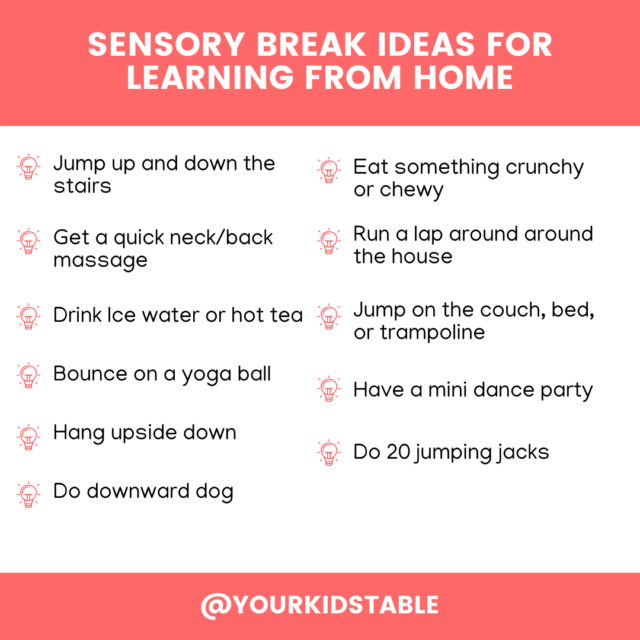
You can create a list of “break ideas” that your child can look at and choose from. Or, write a few options on index cards if having a big list is too many choices for your child. And, if your kid isn’t old enough to read, then give them 2-3 options.
It’s also totally fine to pick the activities in advance and have them planned out. This is another instance of experimenting and choosing what is the most effective and doesn’t cause any stress for you and your child.
Here are some great resources for movement breaks:
- Sensory diet cards – make your own or grab a set of mine to have ready made choices and a ton of ideas at your fingertips
- Brain break videos by GoNoodle – bookmark this channel for a ton of quick fun movement videos
- Cosmic Kids Yoga – get loads of sensory input from these yoga flow videos centered around a variety of kid themes
- 100+ Sensory Activities Ideas – find tons of simple ideas to give your child calming sensory input
Use Alternative Seating
Another awesome thing about homeschooling is that your child doesn’t have to sit in a traditional desk all day, which is really hard for some kiddos. Get creative and allow your child to stand, sit on a yoga ball, use a wiggle seat, lay on the floor, or even sit in a swing.
Remember to observe how helpful any other seating you try actually is. Sometimes it can be more of a distraction, so take note.
And, your kid might need or want to rotate through different positions throughout the day.

Snack Wisely + Keep the Water Flowing
Chewing and sucking are great ways to get sensory input that is calming, so use snacks and drinking water to your advantage.
Plan on having some crunchy or chewy snack available. Also, try to keep these snacks low in sugar and not full of carbs only so that you don’t have a sugar crash and then a sleepy kid that can’t focus.
Instead try:
- Nuts
- Seeds (pumpkin, sunflower, etc.)
- Celery, carrots, and other raw veggies
- Apples
- Raisins
- Oranges
- Granola bars
- Trail mix
Also, have a water bottle ready with a spout on it at the beginning of each day, like this one. A spout top gives a lot more sensory input than an open cup. This also decreases spills, while making sure your child is staying well hydrated – important for focus too!
Provide Simple Sensory Tools as Needed
There are so many school based sensory toys and tools you can use to help your child during the school day, but I’m going to focus on powerful simple items that pack a lot of bang for their buck. Check out some of these ideas:
- Chewy necklaces – If your child likes to bite, chew, or is just really active, having a safe toy to chew on that’s hanging from their neck can improve focus.
- Foot Fidget – Yoga straps or bands are great for providing resistance which gives kids lots of proprioceptive input, which is calming to the whole body. Your child could use a yoga band as part of a movement break, or tie it around the base of a chair and have your child kick it, like in the pic below. You can use any band, or grab these ready made ones.
- Weighted lap pad – You can give your child more of that proprioceptive input with a weighted pillow or blanket across their lap. They don’t need to use this all day, but can be helpful in 10-20 minute intervals. You can also use a small pet for the job, check out the smart idea this mom shared with me on Instagram:
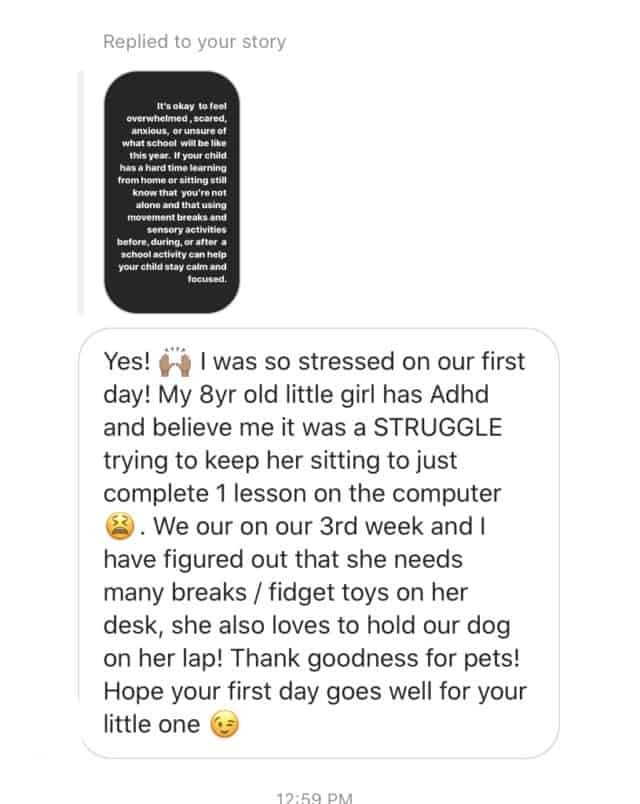
- Fidget Toys – Think of the ever popular fidget spinner from a few years ago, plus about 100 more options! It can be helpful for some kids to have a fidget toy in their hands while they’re trying to focus. Ironically, fidget spinners are often distracting because kids have to focus on balancing them so they work. But, there are lots of other options, check out this more detailed list.
- Yoga ball – Great to have one of these as optional seating, but it’s also awesome for movement activities. Head over to yoga ball activities to get inspired. You won’t believe the ways kids can use one.
Teach Your Child to Tell You When They Can’t Focus
In the beginning, your child will need some help establishing routines, taking movement breaks, and using the other strategies, but eventually they can learn to use all these strategies independently. However, some days are just hard days. Sometimes we can do all the things, but if they’re upset about something, didn’t sleep well, or have a cold, they’re going to struggle more.
Teach them that they can come to you and say, “I’m having a hard time focusing.”
If they know that you understand and that you can step in to provide assistance when it’s really needed, they’ll be much less likely to have a meltdown because they’re at the end of their rope!
**To learn even more, take your learning to the next level and check out our free sensory workshop to uncover 3 expert secrets to calm and focus your child with specialized sensory activities. Click here to grab a seat.
More on Kids and School
Perfect Lunch Ideas for Picky Eaters at School, Home, or Daycare
37 Sensory Toys to Help Kids Learn, Communicate, and Calm Down
7 Tips to Get Picky Eaters Eating the School Lunch
13 Easy Sensory Strategies for the Classroom
Alisha Grogan is a licensed occupational therapist and founder of Your Kid’s Table. She has over 15 years experience with expertise in sensory processing and feeding development in babies, toddlers, and children. Alisha also has 3 boys of her own at home. Learn more about her here.
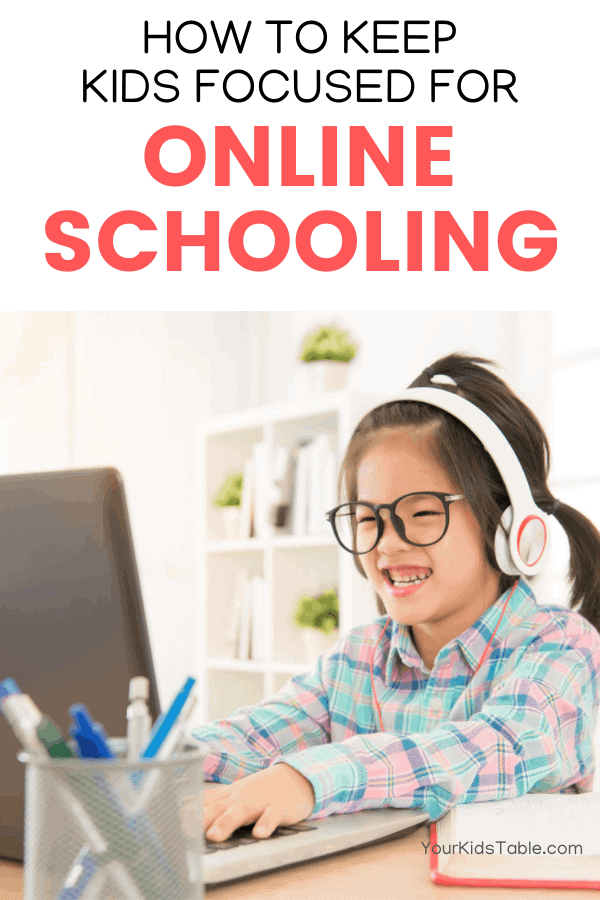
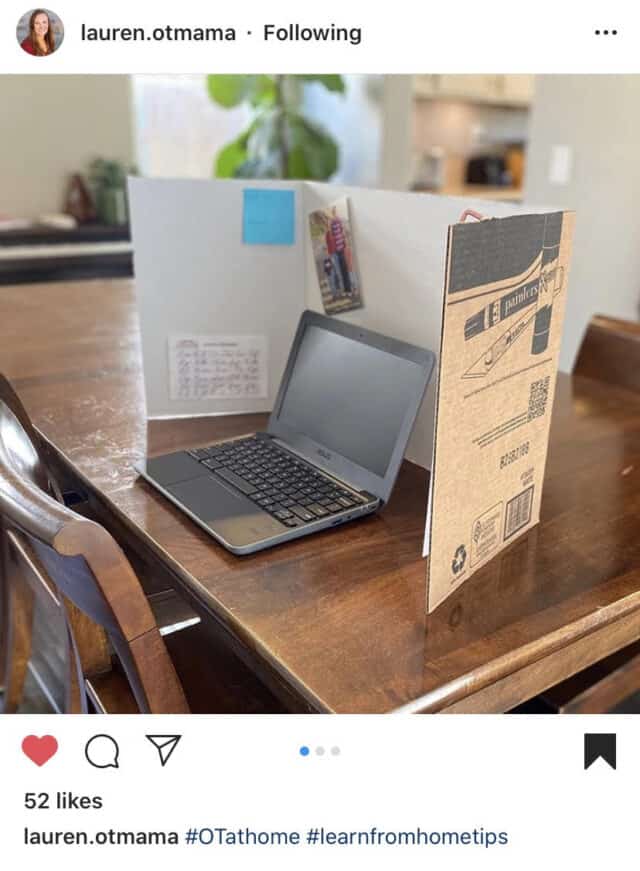
Thanks for sharing my instagram post! It’s like I’m famous now 🙂
I love your instagram account! You’re killing it over there with amazing tips and content, happy to share a fantastic idea and visual!